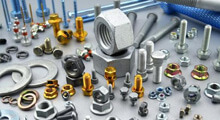Locking or seizure often occurs on screws of stainless steel, aluminum alloy and titanium alloy materials. These metal alloys have anti-corrosion properties. When the surface is damaged, a thin oxide layer is formed on the metal surface to prevent further corrosion. . When the stainless steel screw is locked, the pressure and heat generated between the teeth will destroy this oxide layer, causing blockage or shearing between the metal threads, and then adhesion. When this phenomenon continues to occur, the stainless steel fasteners will be completely locked and can no longer be removed or continued to be locked. Usually this series of actions of blocking, cutting, sticking, and locking occurs in just a few seconds. Therefore, a correct understanding of the use of such fasteners can prevent this phenomenon.
1. Select the product correctly: Before use, confirm whether the mechanical properties of the product can meet the requirements of use, such as the tensile strength of the screw and the guaranteed load of the nut. The length of the screw should be selected appropriately, which shall be subject to 1-2 pitches of the exposed nut after tightening.
2. Before use, check whether the thread is rough, whether there is iron filings or dirt between the threads, these things often cause lockup.
3. Lubricate the fasteners before use: it is recommended to use butter, molybdenum disulfide, mica, graphite or talc for lubrication. At present, wax dipping is commonly used for lubrication and anti-locking.
Precautions
1. The speed and force of screwing in should be appropriate, not too fast or too big. Use a torque wrench or socket wrench as much as possible, and avoid using adjustable wrenches or electric wrenches. Too fast will cause the temperature to rise rapidly and cause lock-up.
2. In the direction of force, the nut must be screwed in perpendicular to the axis of the screw.

 Ali Mall
Ali Mall



